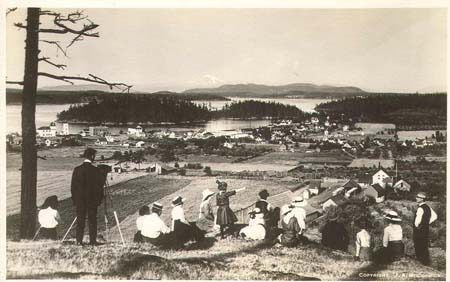Kevin Loftus runs a hand over the weathered timber of a cabin that once housed 11 members of an island pioneer family.
After looking at the same exhibits, buildings and photographs year after year, he is still fascinated by San Juan’s history. Next to that rustic log cabin is a barn full of ancient looking machinery that someone once operated with their own muscle and sweat.
“The challenge is preserving and interpreting those items,” Loftus said, while picking up an old cigar lighter and then an old implement known as a “turn-key,” which island families once loaned to one another to pull out aching teeth.
Now peculiar, these objects were at one time common, household items.
“What gets me is that it [turn-key] was loaned out,” Loftus adds.
As the sun shines brightly outside, the society’s President Mary Jean Cahail, volunteer, Fred Yockers, a volunteer, and Executive Director of the San Juan Historical Museum, Kevin Loftus, are inside the museum’s Resource Center preparing for the society’s 50th Birthday, June 18, on the museum grounds.
With eyes glued to a faded-yellow page of a 1961 edition of the Journal, Yockers exclaims, “Can you believe the price of Rib Eye steak back then?” and,“This is extraordinary, they’ve listed how many rabbits were killed and what weapons were used.”
He is compiling questions for a two-part quiz for the upcoming birthday celebration. He and volunteer Diane Timm are also putting together an exhibit of the Historical Society’s founding members and a remembrance of 1961, the year when the society first came together.
Yockers claims to be no one special, just another lowly volunteer. According to Cahail, there are plenty of people, however, like Yockers, fascinated by the island’s history, but volunteers are much needed to continue the work started by the society’s founding members.
An islander for 55 years, Cahail got involved in the historical society because, as she puts it, “Someone talked me into it and because they’d grab anyone with their socks on.”
During her tenure as president, which began in 2008, Cahail has enjoyed watching how impressed visitors are with the amount of history that has been preserved.
The San Juan Historical Society has more than 1,000 pieces of island history – more items than the society knows what to do with – but it wasn’t always that way.
Prior to the 1960’s, historical items, like Native American artifacts and century-old canned fruits canned over a hundred years ago, were housed in town hall in homemade display cases.
In 1961, a group of islanders decided to take the future of the past into their own hands and placed a small advertisement in the Journal, asking those interested in creating a historical society to meet at town hall for a discussion.
Thirty people showed up, and the Historical Society was formed.
In 1966, George Peacock, an early society member, donated the King family estate to make a home for the museum on Price Street.
Which brings us full circle to today, minus a few years and a lot of historical detail.
Visitors often find a connection to the past. Simple objects like a cigar lighter or early farming equipment bring faded memories to life.
“People will remember something their grandfather once had or of summers on a farm in North Dakota many years ago,” Loftus said.
But the ‘good old days’ sometimes came with a price. There are lesson to be learned and perspectives to gain when looking into the past. In times like now with an economic recession, people can look back and catch a glimpse at how others endured in similar and much harsher situations.
“It’s a chance to learn how people lived, persevered in tough times and lived off the land, they were very self sufficient,” Loftus said. “It is nice to look back with a romantic notion, but there were hardships, like working with dangerous machinery. They did a lot with a lot less than we have now and they actually lived a long time.”
Every night Loftus tries to read a page of island history from old issues of the Journal, to stay in touch with the past.
As the society celebrates its 50th birthday, it too has become another fixture of island history.
“It’s funny because we’re in the history business and we consider anything over 50 years to be historical,” Loftus said.




